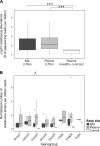Temporal dynamics of the lung and plasma viromes in lung transplant recipients
- PMID: 29979780
- PMCID: PMC6034876
- DOI: 10.1371/journal.pone.0200428
Temporal dynamics of the lung and plasma viromes in lung transplant recipients
Abstract
The human virome plays an important role for the clinical outcome of lung transplant recipients (LTRs). While pathogenic viruses may cause severe infections, non-pathogenic viruses may serve as potential markers for the level of immunosuppression. However, neither the complexity of the virome in different compartments nor the dynamics of the virus populations posttransplantation are yet understood. Therefore, in this study the virome was analyzed by metagenomic sequencing in simultaneously withdrawn bronchoalveolar lavage (BAL) and plasma samples of 15 LTRs. In seven patients, also follow-up samples were investigated for abundance and dynamics of virus populations posttransplantation. Five eukaryotic and two prokaryotic virus families were identified in BAL, and nine eukaryotic and two prokaryotic families in plasma. Anelloviruses were the most abundant in both compartments, followed by Herpes- and Coronaviruses. Virus abundance was significantly higher in LTRs than in healthy controls (Kruskal-Wallis test, p<0.001). Up to 48 different anellovirus strains were identified within a single LTR. Analyses in the follow-up patients revealed for the first time a highly complex and unique dynamics of individual anellovirus strains in the posttransplantation period. The abundance of anelloviruses in plasma was inversely correlated with that of other eukaryotic viruses (Pearson correlation coefficient r = -0.605; p<0.05). A broad spectrum of virus strains co-exists in BAL and plasma of LTRs. Especially for the anelloviruses, a high degree of co-infections and a highly individual and complex dynamics after transplantation was observed. The biological impact of these findings and their relation to clinical variables remain to be elucidated by future analyses.
Conflict of interest statement
The authors have declared that no competing interests exist.
Figures





Similar articles
-
Metagenomic sequencing reveals time, host, and body compartment-specific viral dynamics after lung transplantation.Microbiome. 2022 Apr 23;10(1):66. doi: 10.1186/s40168-022-01244-9. Microbiome. 2022. PMID: 35459224 Free PMC article.
-
Viral metagenomics reveal blooms of anelloviruses in the respiratory tract of lung transplant recipients.Am J Transplant. 2015 Jan;15(1):200-9. doi: 10.1111/ajt.13031. Epub 2014 Nov 17. Am J Transplant. 2015. PMID: 25403800 Free PMC article.
-
Clinical relevance of plasma virome dynamics in liver transplant recipients.EBioMedicine. 2020 Oct;60:103009. doi: 10.1016/j.ebiom.2020.103009. Epub 2020 Sep 24. EBioMedicine. 2020. PMID: 32979836 Free PMC article.
-
[Deep lung--cellular reaction to HIV].Rev Port Pneumol. 2007 Mar-Apr;13(2):175-212. Rev Port Pneumol. 2007. PMID: 17492233 Review. Portuguese.
-
The Virome and Its Major Component, Anellovirus, a Convoluted System Molding Human Immune Defenses and Possibly Affecting the Development of Asthma and Respiratory Diseases in Childhood.Front Microbiol. 2018 Apr 10;9:686. doi: 10.3389/fmicb.2018.00686. eCollection 2018. Front Microbiol. 2018. PMID: 29692764 Free PMC article. Review.
Cited by
-
Virome in immunodeficiency: what we know currently.Chin Med J (Engl). 2023 Nov 20;136(22):2647-2657. doi: 10.1097/CM9.0000000000002899. Epub 2023 Nov 1. Chin Med J (Engl). 2023. PMID: 37914672 Free PMC article. Review.
-
Metagenomic versus targeted next-generation sequencing for detection of microorganisms in bronchoalveolar lavage fluid among renal transplantation recipients.Front Immunol. 2024 Aug 26;15:1443057. doi: 10.3389/fimmu.2024.1443057. eCollection 2024. Front Immunol. 2024. PMID: 39253087 Free PMC article.
-
The Vaginal Virome-Balancing Female Genital Tract Bacteriome, Mucosal Immunity, and Sexual and Reproductive Health Outcomes?Viruses. 2020 Jul 30;12(8):832. doi: 10.3390/v12080832. Viruses. 2020. PMID: 32751611 Free PMC article. Review.
-
Metagenomic Next-Generation Sequencing Reveals Individual Composition and Dynamics of Anelloviruses during Autologous Stem Cell Transplant Recipient Management.Viruses. 2018 Nov 14;10(11):633. doi: 10.3390/v10110633. Viruses. 2018. PMID: 30441786 Free PMC article.
-
Metagenomic sequencing reveals time, host, and body compartment-specific viral dynamics after lung transplantation.Microbiome. 2022 Apr 23;10(1):66. doi: 10.1186/s40168-022-01244-9. Microbiome. 2022. PMID: 35459224 Free PMC article.
References
-
- Lloyd-Price J, Abu-Ali G, Huttenhower C. The healthy human microbiome. Genome Med. 2016;8:51 doi: 10.1186/s13073-016-0307-y - DOI - PMC - PubMed
-
- Pflughoeft KJ, Versalovic J. Human microbiome in health and disease. Annu Rev Pathol. 2012;7(December 2011):99–122. doi: 10.1146/annurev-pathol-011811-132421 - DOI - PubMed
-
- Snyder LD, Chan C, Kwon D, Yi JS, Martissa JA, Copeland CAF, et al. Polyfunctional T-Cell Signatures to Predict Protection from Cytomegalovirus after Lung Transplantation. Am J Respir Crit Care Med. 2016;193(1):78–85. doi: 10.1164/rccm.201504-0733OC - DOI - PMC - PubMed
-
- Dickson RP, Martinez FJ, Huffnagle GB. The role of the microbiome in exacerbations of chronic lung diseases. Lancet. 2014;384(9944):691–702. doi: 10.1016/S0140-6736(14)61136-3 - DOI - PMC - PubMed
-
- De Vlaminck I, Khush KK, Strehl C, Kohli B, Luikart H, Neff NF, et al. Temporal response of the human virome to immunosuppression and antiviral therapy. Cell. 2013;155(5):1178–87. doi: 10.1016/j.cell.2013.10.034 - DOI - PMC - PubMed
Publication types
MeSH terms
LinkOut - more resources
Full Text Sources
Other Literature Sources
Medical

